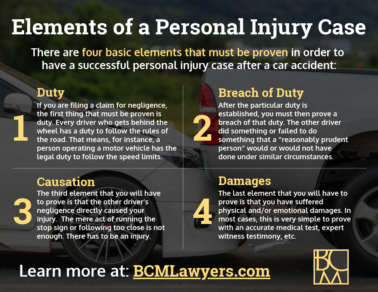How Is Negligence Proven in a Personal Injury Case?
You were involved in a car accident in Mobile. The other driver was cited by the police. The driver’s insurance company did not want to pay you a fair settlement and you have decided to file a personal injury lawsuit. You have been some research and know that you will have to prove that the other driver was negligent. How does that work?
Elements of a Personal Injury Case
You may not believe it, but it takes more than being hurt to prove that the other driver is at fault. There are four basic elements that must be proven in order to have a successful personal injury case:
1. Duty
If you are filing a claim for negligence, the first thing that must be proven is duty. Every driver who gets behind the wheel has a duty to follow the rules of the road.
That means, for instance, a person operating a motor vehicle has the legal duty to follow the speed limits, stop at stop signs and not follow too close.
2. Breach of Duty
After the particular duty is established, you must then prove a breach of that duty. The other driver did something or failed to do something that a “reasonably prudent person” would or would not have done under similar circumstances.
A reasonably prudent person is a fictional person that a jury considers depending on the unique circumstances of each case. For example, driving the posted speed limit is generally evidence of reasonable prudence, but not if there is driving rain, high winds or a blizzard.
A driver breaches his duty in a car accident when he runs a red light, follows too closely, or is texting instead of driving.
3. Causation
The third element that you will have to prove is that the other driver’s negligence directly caused your injury. The mere act of running the stop sign or following too close is not enough. There has to be an injury.
4. Damages
The last element that you will have to prove is that you have suffered damages. In most cases, this is very simple to prove. Typical damages that can be recovered in an automobile wreck are physical pain and suffering, emotional distress, past and future lost wages and the effect of any permanent condition suffered.
The easier a particular element of damages can be quantified by a medical test, a picture or by expert testimony, the better the chance for a full recovery from a judge or jury.
One reason juries often award inadequate damages in a “soft tissue” injury case is that it is hard to show proof of the injury. Unlike a broken arm that shows up on an x-ray or a bulging disc that clearly shows up on an MRI test, a soft tissue case requires more nuance and thought to develop.
That being the case, whether your injuries or serious or just aggravating, it is always in your best interest to at least consult with an experienced personal injury attorney.







Leave a Reply
Want to join the discussion?Feel free to contribute!